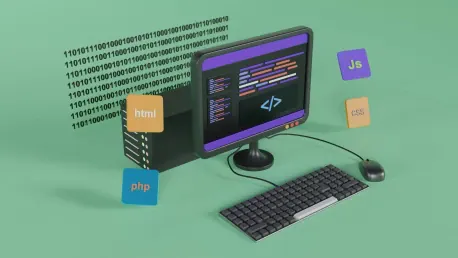The evolution of generative AI and large language models (LLMs) has sparked a transformative wave in AI-driven applications. Despite the rapid growth, developers continue to grapple with complexities in leveraging LLMs effectively. Enter DSPy, an open-source Python framework created at Stanford University that aims to simplify this process. This article explores how DSPy revolutionizes the development of intelligent applications by transitioning from prompt engineering to high-level programming.
The paradigm shift from prompt-based engineering to high-level programming opens up new avenues, making LLM functionalities more accessible and maintainable. Current challenges within the AI landscape—characterized by complex prompt crafting and the unpredictable behavior of LLMs—necessitate such innovation. DSPy addresses these issues by enabling developers to employ compositional Python code to build AI systems. In doing so, it transforms the nascent stages of AI app development into a more modular, scalable, and efficient process. As the digital era rapidly progresses, frameworks like DSPy are pivotal in facilitating the seamless integration of AI into various applications.
Addressing the Pain Points of LLM Development
Traditional LLM app development often involves fragile and time-consuming prompt engineering. Small changes in wording can drastically affect the model’s output, leading to maintenance headaches. Furthermore, prompt logic typically embedded directly into applications makes reusability nearly impossible. This practice forces developers to continuously rewrite and refine prompts, impeding efficient development workflows.
DSPy offers a solution by encouraging the use of compositional Python code for building AI systems, thus making these applications more modular and maintainable. Instead of hardcoding prompts that can easily break, DSPy allows the creation of more robust applications through high-level programming. By abstracting the specifics of prompt creation and allowing the developer to focus on the logic and structure of the AI system, DSPy significantly reduces the developmental complexity associated with LLMs.
This approach is not just a feat of technical ingenuity but also provides a practical advantage. Applications gain enhanced stability and flexibility, ensuring consistent performance even as underlying models or inputs evolve. By leveraging DSPy, developers can reduce the time spent on debugging and maintaining sensitive prompt structures, redirecting their efforts toward optimizing and enhancing the overall functionality of the AI system. The introduction of DSPy thus represents a key advance in the realm of LLM development, transforming an often cumbersome process into a more streamlined experience.
High-Level Programming with DSPy
Rather than focusing on crafting and tweaking prompts, DSPy enables developers to define the behavior of AI models through high-level Python programming. By specifying inputs, outputs, and constraints in code, DSPy abstracts the complexity of prompt optimization. This shift not only simplifies the development process but also enhances the robustness of AI applications to changes.
By emphasizing a high-level programming approach, DSPy moves away from the traditional, often brittle method of prompt engineering. Developers codify the behavior they seek in the AI, aligning it with specified parameters instead of intricately detailing every prompt. This methodology results in more consistent outputs, stabilizing the applications even amidst frequent updates and modifications. Prompts are generated and refined behind the scenes, sparing developers from manual adjustments that can disrupt workflow continuity.
In this new paradigm, DSPy effectively handles the dynamic nature of AI models. For instance, if an update to a language model changes input requirements or expected output formats, DSPy’s underlying structure ensures that the application remains functional without extensive rewrites. The framework’s capacity to auto-optimize and validate configurations means that developers can trust in the robustness of the systems they build. It also enables efficient troubleshooting and scalability, accommodating expanding datasets or additional functionalities with ease.
Optimizers and Self-Improving Pipelines
One of the standout features of DSPy is its optimizer system, which uses advanced algorithms to iteratively improve prompts and fine-tune models. These optimizers experiment with different prompt variations and select the most effective ones based on predefined success metrics. This automation reduces the reliance on trial-and-error, making the optimization process more systematic and efficient.
The optimizer subsystem of DSPy employs machine learning techniques to constantly refine the AI’s performance. By analyzing feedback and metrics, DSPy can make informed adjustments that enhance the system’s accuracy and efficiency. This loop of continuous improvement ensures that AI applications are always operating at their peak potential. An additional benefit is the reduction in manual labor for developers, who no longer need to engage in exhaustive rounds of trial-and-error to achieve desired results.
Moreover, the self-improving pipelines of DSPy facilitate the creation of more intelligent and adaptable AI systems. As the model processes more data, its performance benchmarks continuously ascend, matching and even surpassing initial deployment metrics. Through this powerful capability, developers can create systems that evolve in their functionality and proficiency, adapting seamlessly to changing real-world conditions and data inputs. By integrating such advanced optimizers, DSPy offers a compelling edge in AI development.
Modules and Prebuilt Strategies
DSPy offers a wealth of prebuilt modules that encapsulate common strategies for LLM usage. These modules come with defined input and output interfaces, facilitating the creation of scalable and reusable components. Developers can leverage built-in strategies such as Chain of Thought, ReAct, few-shot examples, and context management, streamlining the development of complex LLM applications.
The modular architecture of DSPy allows developers to build sophisticated AI systems by assembling various predefined components. Each module represents a distinct functionality—such as reasoning, data retrieval, or interaction management—enabling developers to create intricate pipelines without starting from scratch. The framework’s prebuilt strategies come equipped with best practices and optimized configurations, ensuring that developers can achieve high performance with minimal effort. This modular approach supports scalability, ensuring that individual components can be updated or replaced independently as needed.
Furthermore, the use of modules promotes reusability across different projects. Developers can package commonly used logic into modules that can be easily integrated into new applications, significantly reducing development time. This not only increases efficiency but also ensures consistency in implementing best practices across multiple projects. By using a modular strategy, DSPy democratizes advanced AI functionalities, enabling developers of all skill levels to build sophisticated and reliable AI applications.
Model and Library Compatibility
Flexibility is a core strength of DSPy, which is designed to be LLM-agnostic. The framework supports various cloud APIs and local models and integrates seamlessly with popular libraries like Hugging Face and the OpenAI SDK. This allows developers to choose the most suitable models for their specific applications, ensuring optimal performance and versatility.
DSPy’s compatibility with a wide range of models and libraries means that developers are not locked into a single provider or technology stack. This openness fosters innovation, as developers can experiment with different models to find the best fit for their specific use case. The framework’s adaptability also means that it can keep pace with advancements in AI, integrating new models and technologies as they become available. This ensures that applications built with DSPy remain at the cutting edge of performance and capability.
Furthermore, the unified language model interface that DSPy provides simplifies the process of integrating various models. This interface standardizes interactions between the application and the underlying models, reducing the complexity of managing multiple APIs. By abstracting the specifics of different models, DSPy allows developers to focus on building and optimizing their applications, rather than dealing with the intricacies of model integration.
Practical Applications and Use Cases
DSPy shines in several key use cases, including complex question answering with retrieval-augmented generation, dynamic text summarization, and building LLM agents with tool integration. These practical applications demonstrate the framework’s ability to handle sophisticated tasks reliably and effectively, making it a valuable tool for developers.
In complex question answering scenarios, DSPy leverages retrieval-augmented generation to provide accurate and contextually relevant answers. By integrating retrieval mechanisms with generative models, DSPy can pull information from large datasets and generate coherent responses, even for highly detailed or obscure queries. Similarly, for text summarization tasks, DSPy’s modular and high-level programming approach ensures that summaries are not just concise but also retain the essential information from the original text. This makes DSPy an excellent choice for applications requiring precise data condensation, such as news aggregators or research tools.
Building LLM agents with tool integration is another area where DSPy excels. These agents can perform a variety of tasks, from simple calculations to complex process automation, by integrating external tools directly into the LLM workflow. This capability allows developers to create multifunctional AI agents capable of handling diverse tasks within a single framework. The adaptability and robustness of DSPy make it a powerful tool for developers seeking to build comprehensive, versatile AI systems.
Community and Adoption
Despite being relatively new, DSPy has quickly gained traction within the developer community. With nearly 23,000 GitHub stars and 300 contributors, the framework’s rapid adoption is a testament to its usefulness. Already incorporated into over 500 projects, DSPy is poised to become a mainstay in LLM app development.
The strong community support for DSPy is indicative of the framework’s practical value in real-world applications. Developers are drawn to its ease of use, robust performance, and the extensive range of prebuilt modules and strategies. The active community not only uses the framework but also contributes to its ongoing development, adding new features, modules, and optimizations. This collaborative effort ensures that DSPy remains at the forefront of LLM technology, continuously evolving to meet the needs of developers.
Moreover, the widespread adoption of DSPy has led to the creation of numerous tutorials, documentation, and support resources, further lowering the barrier to entry for new developers. This comprehensive ecosystem of support materials makes it easier for developers of all skill levels to get started with DSPy and build advanced AI applications. The framework’s rapid adoption and active community support underscore its status as a vital tool in the LLM development landscape.
The Future of LLM Application Development
Traditional LLM app development often involves fragile and time-consuming prompt engineering. Adjustments in wording can drastically alter the model’s output, leading to maintenance headaches. Additionally, embedding prompt logic directly into applications hinders reusability, requiring developers to continually rewrite and refine prompts, thereby slowing down development workflows.
DSPy presents a solution by promoting the use of compositional Python code to build AI systems, which makes these applications more modular and maintainable. Instead of hardcoding prompts that are prone to breaking, DSPy supports creating more reliable applications through high-level programming. This abstraction allows developers to concentrate on the logic and structure of the AI system rather than the intricacies of prompt creation, significantly reducing the complexity associated with LLMs.
This method is not just technically impressive but also provides a practical advantage. Applications become more stable and flexible, maintaining consistent performance as underlying models or inputs change. By using DSPy, developers can spend less time debugging and managing fragile prompt structures and more time on optimizing and enhancing the overall functionality of the AI system. Thus, the introduction of DSPy marks a significant advancement in LLM development, transforming a typically cumbersome process into a more efficient and streamlined experience.









